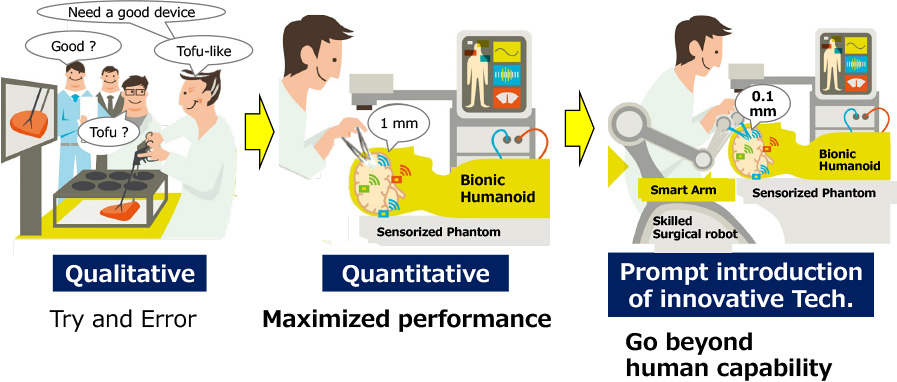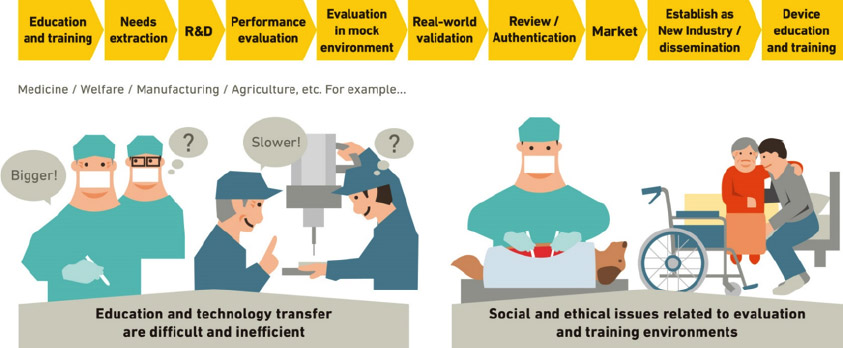Qualitative sensory expressions are used widely in the R&D, evaluation, education, and training in the development of devices for humans, and significant trial and error is involved. The result is that it takes time for seeds for innovative technology to reach society. This program proposes to use “elaborate fakes equipped with sensors” to quantitatively understand qualitative sensory expressions and quickly deliver technology seeds to society by eliminating trial and error. The first target application is the medical field, and we will develop a bionic humanoid, an elaborate human model equipped with sensors to serve as a substitute for humans and test animals. This program will also achieve a medical revolution by developing a smart arm using robotic technology seeds to conduct precision surgeries from small openings. Expanding these results to other industries will lead to a new industrial revolution.

Start the challenge in medicine, where the social impact is great
It takes time for seeds of innovative technology to be brought into actual application and reach the public.
The process of research and development, evaluation, education, and training for equipment that affects human beings, in particular, involves many qualitative sensory expressions, requires trial and error, and is inefficient.
By creating an elaborate imitation equipped with sensors that can be used in place of the real thing, qualitative sensory expressions can be understood quantitatively, trial and error can be reduced, and the process can be accelerated. The Bionic Humanoid will be developed as an elaborate model of a human body equipped with sensors, providing a successful example of this concept.
Impact on industry and society in the event of successful achievement It will realize quantitative, ethical, efficient research and development, evaluation, education, and training, and it will accelerate innovation.
The concept and the elements of technology will be widely deployed in industry, bringing about a new industrial revolution.

Bring together top world-level researchers in measurements, processing, materials, and robots to break through technical barriers. Pursue prompt collaboration with scientific societies in medicine and medical equipment as well as with standards organizations to overcome time and institutional barriers.
Set targets that cannot be achieved without close joint research by the participating institutions.
Technology development that is certain to succeed is assigned to major corporations, while the challenging development is assigned to universities and small to medium-sized enterprises.
Develop a Bionic Humanoid that uses artificial materials to precisely recreate the structure of the head, in particular (membrane of 3-600 μm thickness, etc.).
Develop a Smart Arm (operates with repeated positioning accuracy of 10 μm and delay of less than 100 ms), conduct simulated surgery with it, and show the possibility of a revolution in medical care.
Taking the time risk of standardization and commercialization of results achieved, aggressively promote deployment in industry as elements of technology.
Measure the characteristics of internal organs that are subjects of qualitative sensory expressions, and recreate them using artificial materials with embedded sensors
Using industrial robot arms as a base, develop a safe, intelligent, skilled robot that can be used close to people.
Providing samples, etc., evaluating and using prototypes
Industrial applications by open calls or by designation